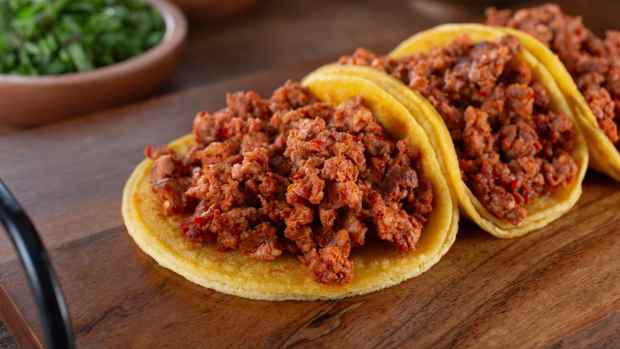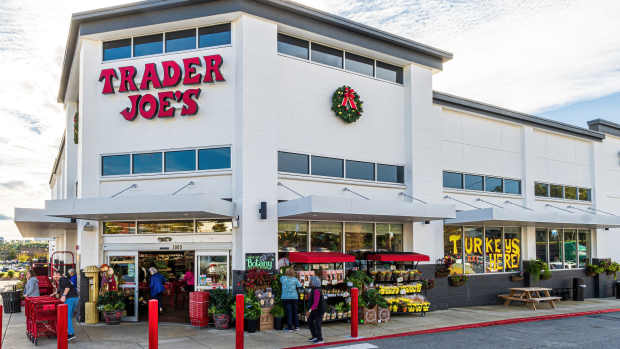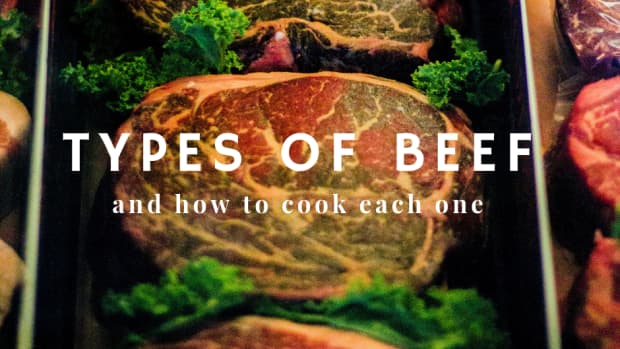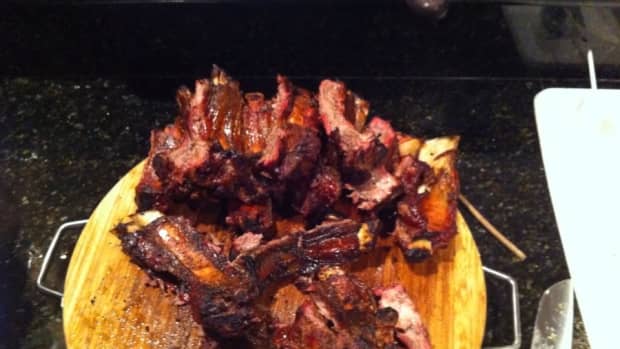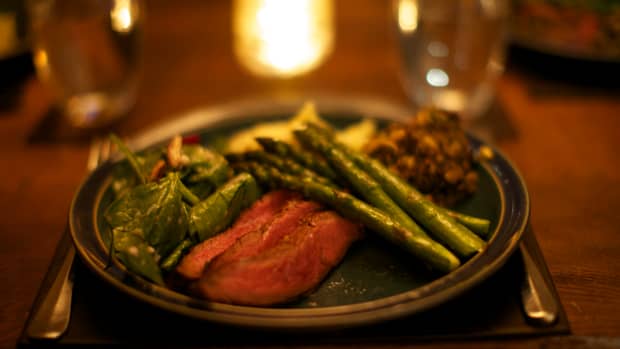What Are Filet Mignon and Beef Tenderloin?
Filet Mignon: The Most Tender Cut of Beef
Beef filet mignon, with its rich marbling of fat, is the most tender cut of beef there is, and it's also my personal favorite.
Many steak aficionados will try to tell you that prime rib, rib-eye steaks, or strip steaks offer more flavor, which, they say, makes them better than the more tender filet mignon. Others prefer lean cuts of meat for grilling, like flank steak, to get the protein without the fat. Others prefer a porterhouse steak or t-bone because they have a small filet and a strip steak in a single cut. But I still prefer the tenderness of the beef filet. To me, it is truly the king of steaks.
What Is the Filet Mignon Cut of Steak?
Filet mignon steak is a cut of beef from the tenderloin that is part of the cow's short loin. The tenderloin runs down the back of a beef cow and is taken from a muscle that gets very little exercise. That lack of movement keeps the muscle tender as the cow matures to the ideal age of 18 months to two years old.
A beef tenderloin is large, usually weighing around 4–6 pounds, and has two parts. The true filet mignon comes from the small circular strip that is attached to the entire tenderloin. In American butcher shops, a filet mignon steak is cut into about two-inch steaks from the entire tenderloin. But if you see filet mignon medallions on a menu, they are typically cut from the extra tender small round strip. It's this small round strip that the French word "filet mignon" is actually referring to.
Beef Tenderloin Vs. Filet Mignon: What's the Difference?
Telling the difference between beef tenderloin and filet mignon can be a little confusing if you're not used to selecting cuts of beef. I once asked my sister-in-law to pick up a beef tenderloin from Costco, and she came home with pork loin!
Beef tenderloin is the name of the large cut of beef before it is sliced into steak. Once it is cut into steaks, those steaks are known by the French name, "filet mignon." I've seen steaks labeled as "beef tenderloin" steaks in the market, and they are the same as filet mignon steaks. However, you'll never see a whole, uncut beef tenderloin labeled as "filet mignon."
To turn a beef tenderloin into filet mignon, all you have to do is take a very sharp butcher's knife and slice the beef tenderloin into 2-inch steaks across the grain of the meat. Once it's sliced, you have filet mignon.
Trimmed Vs. Untrimmed Beef Tenderloin
There are two types of beef tenderloin: the trimmed version of the beef tenderloin and the untrimmed version. The trimmed version has the fat and silver skin from the cow's sides largely removed and is smoothly cut with the side medallion taken out. The trimmed version is more expensive since it has less fat and waste than the untrimmed. The trimmed version is my favorite since it doesn't require any special preparation.
The untrimmed version is a great way to get super high-quality beef at prices similar to those of New York steaks and rib-eye steaks. The untrimmed version requires more preparation since you have to trim it yourself. The process of trimming a beef tenderloin is also known as "peeling." The medallion is removed first by following the seam down the length of the tenderloin with a sharp knife.
Next, the fat and silver skin are peeled and sliced off. Long strips of fat film can be easily pulled off with your hands. Some people like to leave the fat on and cook it off on the grill, but I prefer to remove it. The silver skin is tougher than the other fat and won't break down when cooking, so it's highly recommended to pull it off. It has a "silver" sheen, it's thin, and it runs the length of a large beef tenderloin. Filet mignon (beef tenderloin) has plenty of fat in the meat already. Trimming it off is the way to go!
The Difference Between Grass-Fed and Grain-Fed Filet Mignon
Grass-fed filet mignon is considered a more premium beef product than grain-fed or corn-fed beef. Here's why.
Benefits of Grass-Fed Beef
- Grass-fed beef is more expensive to produce and costs $5–10 more per pound
- It is promoted as a more humane way of raising beef and a more sustainable way to farm
- Grass-fed beef has 1/3 to 1/2 as much fat as grain-fed beef
- Grass-fed beef has a higher percentage of beta carotene that converts to vitamin A (10% of daily allowance in 3.5 ounces)
- Grass-fed beef has three times the amount of vitamin E as grain-fed
- Grass-fed beef has a 60% higher composition of omega-3 fats than grain-fed
- Grass-fed beef has higher levels of conjugated linoleic acid (CLA) which contributes to the health benefits of beef
With all those great benefits of grass-fed beef, how does it taste? Well, my experience with grass-fed filet mignon beef is that it has more flavor, but it is chewier and tougher than corn-fed filet mignon. It's probably tougher because beef that is not finished at a feeding lot for 60 to 100 days has a lot less fat content, resulting in a less marbled, tender filet mignon.
Beef cattle that are grazing in pastures also get more exercise, which keeps them leaner and contributes to a chewier texture of meat. Most people prefer grain-fed or corn-fed beef tenderloin (filet mignon) because it's what we're used to. I know I definitely prefer corn-fed to grass-fed.
58 Calories Per Ounce in Filet Mignon Steak
| 4 ounces | 6 ounces | 8 ounces | 10 ounces | 12 ounces |
|---|---|---|---|---|
232 calories in 4 ounces of filet mignon | 348 calories in 6 ounces of filet mignon | 464 calories in a 8 ounces of filet mignon | 580 calories in 10 ounces of filet mignon | 696 calories in 12 ounces of filet mignon |
What's the Difference Between Choice or Prime Cuts of Filet Mignon?
While the USDA offers a range of beef quality ratings, I would only consider the top two when it comes to filet mignon.
Here Is the Full List of Meat Grades
- Prime Cut: About 3% of all beef is graded prime. Prime is the highest and best rating for beef and contains the most marbling. It's also the most expensive in the market and is usually only available in high-end grocery stores and butchers or at fancy restaurants.
- Choice Cut: A little over 50% of all beef is considered the choice. This is what Costco sells. It's very high quality and the cut of beef I personally recommend it.
- Select
- Standard
- Commercial
- Utility
- Cutter
- Canner
The higher the marbling of the beef ("marbling" refers to the fat white strips running vertically through the beef), the higher the rating. When it comes to filet mignon, I find that the choice cut of beef tenderloin is an excellent selection. While prime cuts are technically better, there is little extra value in spending the additional money to get a prime filet mignon steak, in my opinion.
How to Grill Filet Mignon
For more detailed instructions, see my full recipe with step-by-step photos on how to grill filet mignon.
Filet mignon is such a wonderful cut of beef that the simpler preparations are the best. My filet mignon recipe is super simple. Start by taking the filet mignon out of the refrigerator and let the internal temperature of the meat come to room temperature. Filet mignon that is grilled at room temperature will cook more evenly. I usually take it out of the fridge 30 minutes to an hour before I want to grill it.
A Few of My Favorite Preparations Include:
- Garlic salt to taste
- Pepper to taste
- Pad of butter on each steak
- Wrap each filet with one piece of bacon and insert a toothpick to hold bacon in place (for bacon-wrapped filet mignon)
The secret to cooking the best filet mignon recipe ever is removing the filet mignon from the grill at exactly the right temperature. The USDA temperature for medium-rare is 140 degrees, but if you wait to pull your filet from the grill when the meat hits 140, it will continue to cook even after it has been removed from the heat. You'll end up with way overcooked steak.
To get the perfect medium-rare filet mignon, use an instant-read meat thermometer and pull the meat from the grill at 120 degrees. Let it stand tented in tin foil for ten minutes before serving.
To serve filet mignon at a medium temperature of 160 degrees, as recommended by the USDA, you need to pull the filet mignon from the grill at 130 degrees. If you want it a little more pink, pull it at 125 degrees and let it stand for ten minutes. I hate to repeat myself too much, but perfectly cooked filet mignon really is all about getting the temperature right. You can always add more salt and pepper to taste, but if you overcook the meat, you can't fix it. It's worth investing in a great instant-read thermometer for barbecuing premium meats like filet mignons.
I also grill the entire beef tenderloin and slice it into filet mignon steaks after I pull it from the grill. I usually start with a whole beef tenderloin from Costco. I liberally apply garlic salt and pepper the entire beef tenderloin and then lightly spray it with PAM to hold the seasoning on and to prevent the beef from sticking to my grill. When you're ready to grill, heat your barbecue to 500+ degrees and sear the meat for about three minutes per side. While the outside is searing, take your digital remote meat thermometer and set it to 120 degrees.
Next, place the entire beef tenderloin on the side of the grill to cook the meat with indirect heat. Place the meat thermometer in the thickest part of the beef. Be sure you insert the tip of the thermometer very slowly while carefully watching the temperature as you go. Continue to insert the thermometer until the temperature starts to decrease again. This way, you know when you have the thermometer in just the right spot for an accurate reading of how well the meat is cooked.
Shut the lid on your grill and bring the temperature down to about 300 degrees. To cook an entire beef tenderloin, it usually takes about 30 minutes (then 10 minutes to rest). Finally, slice the tenderloin into filet mignon steaks. I use a serrated electric carving knife.
Cooking a Whole Beef Tenderloin
A beef tenderloin doesn't need to be sliced into steaks before cooking. It can be cooked whole. The key is to tie the meat up tightly so that its thickness is consistent.
The Best Way to Tie It Up
- Start with cooking string at one end and tie a tight double knot.
- With the help of another person, wrap the string in a spiral around the meat to the other end. The spiral loops should be spaced one to two inches apart.
- Tie the other end off with another double knot.
By using this technique, you can be sure that your meat will cook more evenly. I highly recommend it if you're cooking an untrimmed tenderloin.
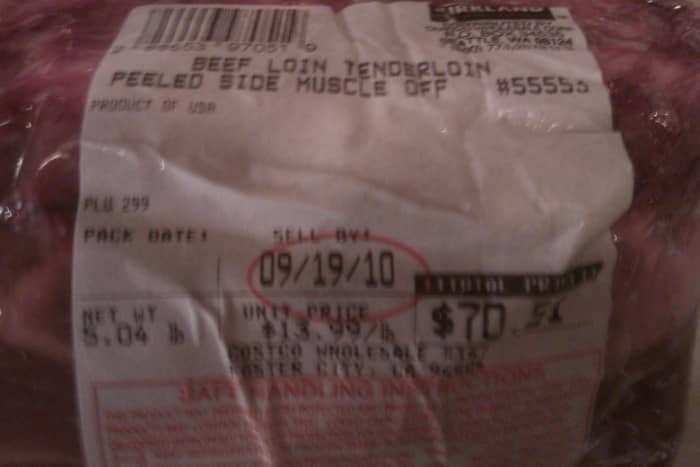
Beef tenderloin before it is sliced into filet mignon steaks (5-lb whole beef tenderloin from Costco that cost about $70).
Paul Edmondson
Where to Buy Filet Mignon
I haven't found a better deal for buying beef tenderloin to slice into filet mignon steaks than the prices at Costco. The only downside is you inevitably end up with several pounds of filet mignon (I prefer to eat it right away rather than stick the extra steaks into the freezer). But buying a beef tenderloin and slicing it into filet mignon steaks will save you at least three dollars per pound for choice-cut meat, so this is a good option for most people.
I personally get a lot of joy out of purchasing meat from a butcher. I've even found that many butchers will give you a discount if you ask for it. Not every butcher will, but you can always ask, "Hey, can you give me a special on Filet Mignon steaks today?" Often, they will slice you off some great steaks and mark the price down quite a bit, but only if you ask.
I generally stay away from buying filet mignon from places that ship frozen steaks to your house (like Omaha Steaks). While many of them offer price discounts for prime cuts of beef and have special containers that keep the meat frozen for long periods of time, I find frozen meat inconvenient to eat. Thawing takes time and planning, and I tend to lose steaks in the freezer for long periods of time and then find them too old to eat later.
I recommend purchasing the day of or the day before you intend to eat. It's also a good idea to only buy enough filet mignon to feed the number of people you want to serve. Plan for about 8 ounces per person. This is a healthy-sized serving that may result in some leftovers for the next day.



Simple Recipe for Filet Mignon
For Christmas Eve dinner, my family wanted a tasty but easy-to-prepare meal. We decided to barbecue a whole filet mignon roast (beef tenderloin). Here's the recipe we used.
Filet Mignon Recipe Instructions
- Lightly drizzle the meat with vegetable or olive oil.
- Sprinkle with Truffle Salt or coarse salt (a medium amount).
- Sear the meat over high heat on all sides for about two minutes per side.
- Lower the temperature to medium or medium-high heat to get the grill to 375 degrees.
- Insert the meat thermometer into the filet mignon and cook to 125 degrees.
- Let rest for ten minutes, slice and serve.
- Optionally, serve horseradish on the side.
It was a hit! This recipe is unbelievably easy to do, and the truffle salt gives it an exceptional and unique flavor. My family loved it.
Questions & Answers
Question: Is it wise to buy a tenderloin now and freeze it for three weeks to make Beef Wellington?
Answer: A beef tenderloin can be frozen for three weeks. The key is to fully de-thaw the meat before cooking. I usually do this on the counter for 12 hours and then in the fridge for a day. The meat will be great for any type of dish or grilling.
Question: Why was Costco 'Prime trimmed' tenderloin $3.00 more per pound than their 'choices trimmed' filet mignon? Shocking to see both were nicely trimmed, but 3.00 more per pound?
Answer: So, Prime is more expensive, but in my opinion, choice is a better value. Just make sure your comparing trimmed to trimmed and untrimmed to untrimmed.
Question: How do I grill a very rare beef tenderloin?
Answer: The best way to grill extremely rare beef tenderloin is to grill it indirectly at a low heat (250 degrees). This will slowly raise the temperature. For bloody rare, still mooing beef, pull it at 110 degrees. Use an internal meat thermometer. Let it rest ten minutes and then slice and serve. Note, this will be very, very rare.



